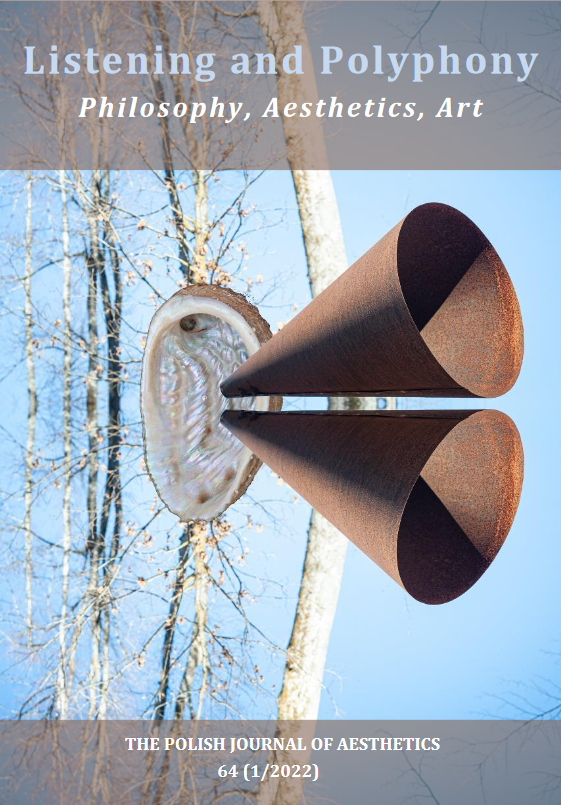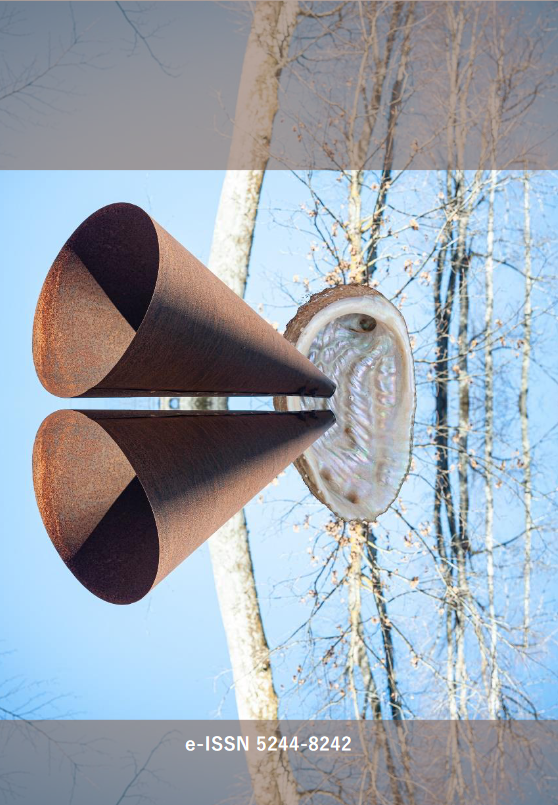Numer 64 (1/2022)
Listening and Polyphony. Philosophy, Aesthetics, Art|
Spis treści
Strony
Pobierz
|
|||||
|
|
|||||
|
INFORMACJE O AUTORACH Maja Bjelica Znanstveno-raziskovalno središče Koper, Słowenia Ineta Kivle Uniwersytet Łotewski Lenart Škof Znanstveno-raziskovalno središče Koper, Słowenia |
|||||
|
Salomé Voegelin,
Mark Peter Wright Points of Listening: Reflections on the Participatory and Polyphonic Potential of Communal Sonic Practices
DOI: 10.19205/64.22.1
19 – 36
|
|||||
|
Słowa kluczowe participation |Collectivity |Communal |Polyphony |ListeningStreszczenie How might polyphony operate across the collective, communal, and participatory dimensions of sonic practices? What aesthetic and political observations can be gleaned from listening and sound making that attend to the simultaneous affects of shared sonic experiences? This essay reflects on the possibility of plurality in collective and participatory listening and sound making in relation to the project Points of Listening (PoL), an ongoing series of workshops and discussions, co-convened by the authors, in association with Creative Research into Sound Arts Practice, CRiSAP, University of the Arts London. INFORMACJE O AUTORACH Salomé Voegelin CRiSAP, London College of Communication, UK Mark Peter Wright CRiSAP, London College of Communication, UK |
|||||
|
Maja Bjelica
The Ethics of Deep Listening: A Practice for Environmental Awareness
DOI: 10.19205/64.22.2
37 – 56
|
|||||
|
Słowa kluczowe Environmental Humanities |Ethics of Listening |Deep Listening |Pauline Oliveros |Sound StudiesStreszczenie This paper is attuned to a frequency that searches for an embodied practice of an ethics of listening that considers the human other and other beings and things or environments, thus contributing to the ethical inhabiting of the more-than-human world. The paper presents the compositional and meditative practice of Pauline Oliveros, called Deep Listening, connecting it to the contemporary and emerging fields of sound research, such as acoustic ecology, acoustemology, and ecomusicologies, as echoing one another in the process of transforming the human attitude towards the environment into a more attentive sharing of our habitats and cohabitation in awareness. INFORMACJE O AUTORZE
Znanstveno-raziskovalno središče Koper, Słowenia
|
|||||
|
Piotr Sawczyński
Listening to the Unsaid: Giorgio Agamben and the Politics of the Human Voice
DOI: 10.19205/64.22.3
57 – 67
|
|||||
|
Słowa kluczowe Walter Benjamin |Giorgio Agamben |voice |InfancyStreszczenie The article aims to critically analyze Giorgio Agamben’s philosophy of the human voice—his early contribution to the academic debate on speaking and listening. I reconstruct both Agamben’s critique of the traditional metaphysical approach to the human voice and his theory of infancy, conceived as an alternative mode of conceptualizing voice and aimed at reformulating speaking and listening as unifying experiences beyond particular languages and linguistic identities. INFORMACJE O AUTORZE
Akademia Ignatianum w Krakowie
|
|||||
|
Sergio J. Aguilar Alcalá
Another Voice: Towards an Aesthetics of the Voice in Cinema
DOI: 10.19205/64.22.4
69 – 86
|
|||||
|
Słowa kluczowe psychoanalysis |Cinematic Voice |Suture |Lalangue |SuperegoStreszczenie This paper proposes a model to understand the voice in cinema, constructed via psychoanalysis and classical cinematic sound theory. The voice as an object (as it is for psychoanalysis) supposes a hole in the Other, an object that slips meaning. Kaufman and Johnson’s 2015 film Anomalisa is commented on along these lines. This movie renders visible the way the cinematic language sutures the subject (a character in the film) and the Other (the diegetic reality). |
|||||
|
Rafał Solewski
The Polyphonicity of Artistic Practice and Interpretation as a Tale about It: The Art of Piotr Jargusz in the Context of the Thought of Władysław Stróżewski and Roman Ingarden
DOI: 10.19205/64.22.5
87 – 101
|
|||||
|
Słowa kluczowe art |Polyphony |sense |Piotr Jargusz |TaleStreszczenie The text discusses the painting-performative art of Piotr Jargusz and the polysensory and immersive way of its reception and interpretation planned by the artist to be formed as a tale. The art and the tale are presented as a two-voice whole with a standard polyphonic set of aesthetically valuable qualities (according to Roman Ingarden’s terminology). Such a whole goes beyond the division into areas of perception determined by the senses and domains of arts, ultimately revealing the essential sense of reality. It is discovered by the mythos of art (represented by the artist’s actions) and the mythos of art science (represented by the tale-interpretation). The concept of mythos is introduced by the philosophy of Władysław Stróżewski, Ingarden’s student and associate. The paper offers a proposal to classify several planes of polyphonicity based on the described situation. INFORMACJE O AUTORZE
Uniwersytet Komisji Edukacji Narodowej w Krakowie
|
|||||
|
Andrzej Krawiec
The Art of Fugue by Johann Sebastian Bach as an artistic expression of the juncture of beyng in Martin Heidegger’s philosophy
DOI: 10.19205/64.22.6
103 – 118
|
|||||
|
Słowa kluczowe art |Heidegger |Bach |Fugue |phenomenologyStreszczenie Listening and polyphony lead us directly to reflection on the musical form of the fugue. Starting with M. Heidegger’s considerations about the juncture of beyng, we will phenomenologically ask about the essence of the fugue, and the musical work put under analysis will be The Art of Fugue by J.S. Bach. The article aims to show the convergence between Heidegger’s philosophy and the essence of the musical form of fugue as an artistic mode of the essential occurrence of beyng as an event. INFORMACJE O AUTORZE
Uniwersytet Jagielloński w Krakowie
|
|||||
|
Alistair Macaulay
The Autonomy of Expression and the Becoming Musical of Classicism, Romanticism, and Modernism
DOI: 10.19205/64.22.7
119 – 134
|
|||||
|
Słowa kluczowe music |becoming |Deleuze |Stratification |expressionStreszczenie This article reconstructs Deleuze and Guattari’s history of music in relation to their notion of stratification and defends the view that music is an organization of sounds. Tracing a history of becoming music, this article demonstrates how social conditions impact the organization of sound into music and how music transforms those same social formations. Deleuze and Guattari’s notion of double articulation, a regime of content and a level of expression, provides a rubric to understand how sonic material is organized into determinate musical elements, notes, tones, rhythms, and so on. This article argues that as the articulation of expression grows independent of content, there is a commensurate increase in what can become musical. INFORMACJE O AUTORZE
Deakin University, Australia
|
|||||
|
Kritika Tandon
Timbre, Identity, Difference: Witnessing Polyphony in Darkness
DOI: 10.19205/64.22.8
135 – 149
|
|||||
|
Słowa kluczowe Polyphony |Timbre |identity |Sound |DarknessStreszczenie This paper tries to study timbre not only as an attribute of self-sameness for providing identity in sound but as difference, contradiction, and variation. It is divided into two sections: Timbre and Identity, explored through the works of Ihde, Derrida, and Nancy; Timbre and Difference, studied through the works of Benjamin, Ingarden, and Bakhtin. I then take up darkness, a positive openness for the simultaneous existence of voices, as the dimension of timbre in polyphony. INFORMACJE O AUTORZE
Indian Institute of Technology, Delhi, Indie
|
|||||
|
|
|||||
|
Słowa kluczowe J. G. Hamann |Tonality |nature |Senses |songStreszczenie If we look at the impressions and influences of Johann Georg Hamann, an Enlightenment-era thinker, in the context of Livonia and Courland from the aspect of producing text and thought, then J. Ch. Berens’ project of an enlightened commercial republic in Riga appears as its first episode and as a far-reaching thought complex. Hamann’s studies have a philosophical-cameralistic character. They provided a broad modern vision in fragments. The thought complex, where recourse to Latvian folk songs and their meter and tonality appears in the “Aesthetica in nuce” (1762), also rests on this ground. The passage at the end of “Aesthetica” is once instrumentalized in identity politics, solidified, and mythologized even within the framework of Latvian national culture. However, the text passage is extraordinarily complex and interwoven with several layers of context in Hamann’s contemporary environment. One of the critical concepts in this passage is “monotony.” This concept needs to be addressed in more detail, as it does not universalize and unify but individualizes and divides. Hamann’s monotony is paradoxical: the unity of the world is linked to the diversity of the world’s sounds and colors, languages, and times: the world itself is a paradoxical monotony. With recourse to “Socratic Memorabilia” and various passages from “Aesthetica in nuce,” this paper shows that this folk poetry passage becomes more understandable only when considering the background of Hamann’s main ideas. Since singing and possible poetry can be found in Hamann, a Hamannian series of thoughts “God-Nature-Language-Senses-Poet” is turned and solidified national-culturally with the help of Herderian motifs. There is no such consolidation in Hamann. Indeed, his theological-eschatological philology of listening and tonality of nature at the end of the “Aesthetica” contains a prefiguration taken up and continued on this side of Hamann’s statements in modernity. INFORMACJE O AUTORZE
Uniwersytet Łotewski
|
|||||
|
Anne Sauka
Beyond the Skin Line: Tuning into the Body-Environment. A Venture into the Before of Conceptualizations
DOI: 10.19205/64.22.10
161 – 181
|
|||||
|
Słowa kluczowe embodiment |Emergence |Processuality |Intercarnality |Embodied Critical ThinkingStreszczenie The article explores embodied critical thinking (ECT) for engaging with the enfleshed and trans-corporeal self on an affectual and experiential level. By discussing three exemplifying affectual instances that expose the experiential level of processuality, emergence, and intercarnality, the article shows the methodological use of ECT as a fruitful approach to developing embodied ontologies and a toolkit for the experiential reflection of one’s enfleshment, as tuning into the body-environment. INFORMACJE O AUTORZE
Uniwersytet Łotewski
|
|||||
|
|
|||||


